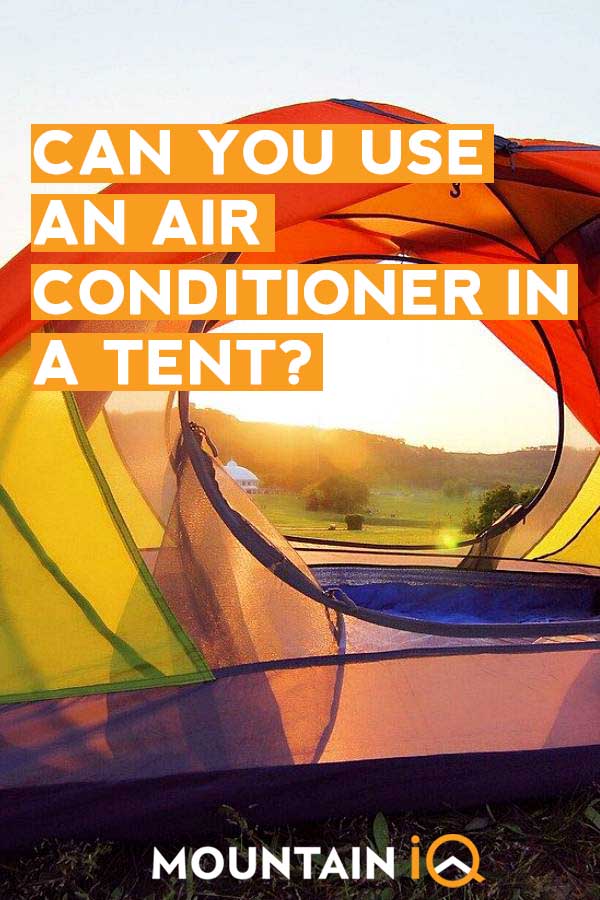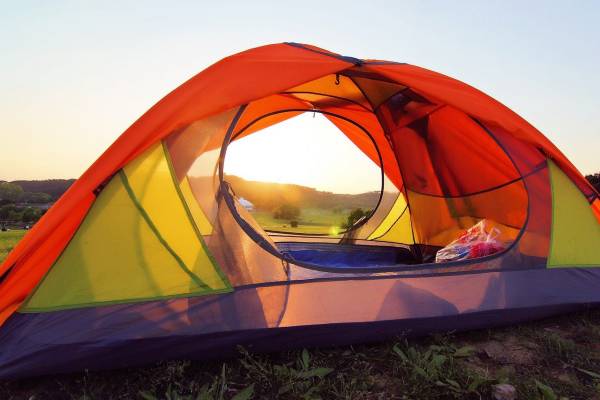Depending on your needs, there are many kinds of tent air conditioners you can use while camping. Window air conditioners and portable air conditioners are the two main types of units that are used for cooling down tents.
Window air conditioners tend to be more affordable and powerful but can be difficult to set up in a campsite. Portable AC units are freestanding but require an exhaust pipe to release the hot air outside of the tent.
You could opt for a smaller cooling system that plugs into a portable power station with a USB if for personal use or if you have a small tent.
Best Tent Air Conditioners (Top Picks)
Best Overall
Personal Fan
This article contains affiliate links. If you buy something through the links on this page, we might get a small commission. It will not affect your price but helps keep our site alive!
Top Air Conditioners For Tents
Here are some good air conditioners for tents:
- BLACK+DECKER Portable Air Conditioner - Best Overall
- hOmeLabs 14,000 BTU Portable Air Conditioner - Quiet
- Frigidaire Compact AC
- Evapolar evaCHILL Personal Air Cooler
- LG 6000 Portable Air Conditioner - Best Design
- Odoland Portable Camping Lantern with Fan
Read our complete buyers guide for tent air conditioners.
Best Overall Tent Air Conditioners
1. BLACK+DECKER Portable Air Conditioner
This portable air conditioner serves as both a cooler and heater, keeping your space comfortable year round. The BLACK+DECKER Portable Air Conditioner is quiet and comes with a remote control, 4’11” (1.5 m) exhaust hose and window kit.
The air conditioner is easy to use, clean, and move around as it comes with caster wheels and handles. The unit is adaptable – it can be used in a tent or at home through double hung or sliding windows.
Designed for smaller spaces, this unit cools spaces up to 300 square feet (28 square meters) to 64 ºF (18 ºC) or heats up to 95 ºF (35 ºC).
Main Features
What we like
What we dislike
2. hOmeLabs 14,000 BTU Portable
The hOmeLabs 14,000 BTU Portable Air Conditioner cools spaces up to 700 square feet (65 square meters) and is easy to set up, move around and clean. The unit even reminds you when to clean the filter!
This AC comes with a built-in 100-pint (47-liter) dehumidifier, which releases the resulting hot air through the exhaust hose. A drain hose is included for the dehumidification function, as the unit doesn’t come with a water reservoir tank.
The hOmeLabs Portable AC has many customization options – like temperature, cooling modes, fan speed and an eco-friendly sleep mode, which you can control using the LED display or the remote control.
Main Features
What we like
What we dislike
3. Frigidaire Window-Mounted Compact AC
The Frigidaire Compact AC is a small, simple and energy-efficient unit that can cool a room up to 150 square feet (14 square meters).
In addition, the unit has dehumidification capabilities of 26.4 pints/day (12.5 liters/day). The product has mechanical rotary controls to adjust the cooling speed, fan speed and air direction.
In the event of a power failure, this unit easily restarts itself and resumes operation at your chosen settings.
Main Features
What we like
What we dislike
4. Evapolar evaCHILL Personal Air Cooler
The Evapolar evaCHILL Personal Air Cooler is a sleek and aesthetically pleasing personal AC unit. This cooler is low on energy use and is designed to cool down your immediate space up to 45 square feet (4.2 square meters).
This is perfect for a small tent or to place on your camping table and sit in front of on a hot day. The unit can work for up to 9 hours without requiring water replenishment and has the option of a night light, so it can also be used for children’s bedrooms at home.
The unit is light, compact and easy to use. It also doesn’t use any toxic substances, like Freon, or any organic substances that may propagate mold or pathogenic bacteria.
Main Features
What we like
What we dislike
5. LG 6000 Portable Air Conditioner
AC units are, on the whole, not pretty, but LG has managed to make a sleek, beautifully designed unit that you don’t have to hide away in the corner of the room. The LG 6000 Portable Air Conditioner is free standing and has dehumidification capabilities of up to 43.2 pints/day (20.4 liters/day).
The unit is able to cool up to 150 square feet (14 square meters) and has auto swing louvers that make sure the entire space gets cooled. It’s fairly hefty, at 58.4 lb (26.5 kg), but is portable and can be plugged into any standard 115 V electrical outlet.
Main Features
What we like
What we dislike
6. Odoland Portable Camping Lantern with Fan
This product is a two-in-one bargain. At only $17 on Amazon, the Odoland Portable Camping Lantern with Fan has a hook that can be attached to the top of your tent and used as a lamp and ceiling fan. It can also be stood upright and used as a standing fan.
The unit is extremely light, at only 1.2 lbs (0.54 kg), making it super easy to carry around while camping. The lantern operates on 2D batteries, which can be used as a fan (on low speed) for up to 50 hours, or as a fan and light for up to 16 hours.
Main Features
What we like
What we dislike
The Bottom Line
Small portable AC units
If you’re going camping for a longer period of time, or if you know that it’s going to be very hot, then you might consider lugging a portable AC unit with you. Some of these, like the hOmeLabs Portable Air Conditioner are quite powerful at 14 000 BTU. The benefit to this is that it can cool a much larger area of space, although such a high cooling capacity might not be necessary for camping. The unit is also heavy, weighing 72.3 lb (33 kg) and expensive.
Most other portable AC units have a power rating of 8 000 BTU, like the BLACK+DECKER and LG 6000 Portable Air Conditioner units. Of these, the LG unit has the best appearance, but is more expensive. The BLACK+DECKER portable unit is the lightest and has the added benefit of being able to heat as well as cool, making it useful in all seasons. This unit is noted to only be able to cool small spaces, which is fine for the camping purposes.
Despite being inexpensive, the Frigidaire Compact AC is a window unit, which means it isn’t the most convenient for camping as it needs an exhaust hole that will accommodate the entire unit.
Personal fans
If you’re just looking for something small and light, and you don’t need to cool down a large space, then a battery powered fan or personal cooler is a better option. The Evapolar evaCHILL Personal Air Cooler runs on electricity and can be plugged into a power supply with a USB port. It is a bit pricey and has been said to be quite noisy.
If you really want something small, cheap, functional and simple, then the Odoland Portable Camping Lantern is probably the one for you. It’s designed for camping and is so light that it can even be taken backpacking. It won’t be able to cool a large space (or a very hot one), but it runs on batteries so you don't need to plug it in to anything.
Best Tent Air Conditioner - Buyer's Guide
Can you use an air conditioner in a tent?
There are certain types of air conditioners that you can use inside your tent when you're camping in the summer time.
Window air conditioners and portable air conditioners are the two main types of units that are used for cooling down tents. Window air conditioners tend to be more affordable and powerful but can be difficult to set up in a campsite. Portable AC units are freestanding but require an exhaust pipe to release the hot air outside of the tent.
For personal use or if you have a small tent, you could opt for a smaller cooling system that plugs into a portable power station with a USB.
Taking an air conditioner camping with you in the summer time can make your experience significantly more pleasant. It will keep you cool, prevent heat stroke and help you to sleep better during the night as there's nothing worse than being in a hot, clammy tent.
What is the best type of air conditioner for camping?
Before you rush in and buy a portable AC for your summer adventure, there are a few things you need to consider about your campsite amenities and your camping needs. When choosing your tent AC unit, you’re going to want to consider how portable the unit is, how big it is, whether or not it needs a power source, how noisy it is and how much it costs.
Types of Air Conditioners
There are many different types of AC units – some are better for camping trips than others. Here are a few of your options:
Window air conditioners are generally used in apartments (you’ll often see them hanging out of windows on apartment blocks). They are relatively powerful, usually around 5 000 BTU, and can cool a small apartment. They’re not too easy to move around as they don’t have wheels, and they don’t have an exhaust pipe so they need to be vented to an area the same size as the back of the unit.
Portable air conditioners are ones that have wheels and an exhaust pipe. They can be quite big and powerful, but you can find ones with a power output of about 8000 BTU. They also often have built-in dehumidifiers.
Spot coolers are heavier and more powerful portable air conditioners. They’re heavy and robust and are generally used for more permanent locations.
Fans are great if you just need a bit of ventilation and a light breeze, but aren’t particularly effective in very hot and humid conditions. That being said, if you just need something simple, they are light on power usage and in weight. You could even get a camping lantern with a fan attached to save you the trouble of bringing the two separate items.
Noise
You’ll notice how much quieter it is when you’re out of the city and in nature. You don’t want to ruin that by having a noisy, rumbling AC going all night while you’re trying to sleep and appreciate the quiet wilderness. Noise levels on products can generally be checked – anything under 60 db should be fine – but if not, consumer reviews are always a good indication of how noisy a unit is.
Cooling & Heating
Depending on how much use you want to get out of the unit, it may be a good idea to look into purchasing a dual-purpose AC. Some units have the capacity to cool and heat, which is perfect if you’re a year-round camper, or if you want to use the unit in your home during colder months. This may add to the cost but can make your camping experiences more comfortable in any season of the year.
Material
Quality is always an important consideration, especially with expensive camping gear. Look out for the product specs to see what the unit is made of, as well as what its reviews say. If the product seems too cheap, it may be because it’s cheaply made and will break after a few uses. It’s better to invest in something that will last a lifetime.
Safety tips
It’s quite safe to use an AC in a tent, as long as you make sure to follow the product guidelines and ensure adequate ventilation.
Continue browsing
See more outdoor gear reviews and our detailed camping tent guide. Or check out these reviews:








